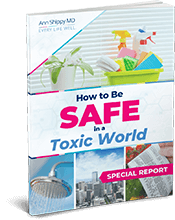Practically everything we own has been doused with flame retardants: furniture cushions, mattresses, pillows. Almost all children’s products contain high doses of flame retardant as well, like bouncers, pajamas, car seats, toys….
For years, advocates and researchers have warned about the damaging toxins in flame retardants. One chemical is known to cause cancer in animals and another is a suspected endocrine-disruptor that may affect the way the body controls fat metabolism. The chemicals also have long-lasting environmental effects.
The Environmental Working Group and Duke University published a study in July 2016, which compared chemical exposure (from flame retardants) among kids in California and kids in New Jersey. The results can frighten any concerned parent:
“On average, the California children in the study had been exposed to the carcinogenic flame retardant TDCIPP in amounts that were more than double those detected in the New Jersey children. Younger children were the most highly exposed. Mothers in California also had higher exposures to TDCIPP than their New Jersey counterparts, but differences were not as extreme as in the children.”
Researchers found two other toxins, BDCIPP and DPHP, with staggering toxicity levels among Golden State kids. California children were 15 times higher than their mothers’ for BDCIPP, while in New Jersey they were five times as high. DPHP in California children was six times higher than that in their mothers, compared to just three times higher in New Jersey. One case in California had a child’s level of BDCIPP that was 291 times higher than the mother’s.
The use of flame retardant in California is unique. California adopted a policy in 1975, known as Technical Bulletin 117 (TB117). The study explains that TB117, “required that polyurethane foam used in furniture cushioning be able to withstand ignition for 12 seconds when exposed to an open flame. The cheapest and easiest way for furniture manufacturers to meet this requirement was to add flame retardant chemicals to the foam.” The Duke study revealed what we’ve known for a very long time—that TB117 and use of flame retardants—has lead to a public and environmental health threat.
The good news is that federal and state governments are now requiring manufacturers to change the use of flame retardants, and are banning some of them.
In April 2016, Washington state passed the Toxic-Free Kids and Families Act. It banned five of the worst flame retardants and created a process for the Departments of Health and Ecology to make recommendations on six others.
In May 2016, Congress voted unanimously to overhaul a 40-year-old law that will make it harder for manufacturers to use flame retardants. The Toxic Substances Control Act was signed into law in 1976 by President Gerald Ford and changes to it will empower the Environmental Protection Agency to obtain more information about a chemical before approving its use. The Washington Post reports: “Under the bill, instead of going through a lengthy rule-making process to trigger product testing, the EPA can order companies to test their new products. The measure also imposes user fees on industry to help expand the testing of chemicals.”
The measure will impact everyday items like detergents, paint thinners, furniture cushions and children’s products.
Many manufactures are already on board with the idea of banning flame retardants. The Chicago Tribune reports that: “Crate and Barrel, Room & Board, and Williams-Sonoma (Pottery Barn, West Elm) all say they have mostly eliminated the chemicals from their products. IKEA, La-Z-Boy, The Futon Shop, Scandinavian Designs and Wal-Mart also said they have told vendors to stop adding flame retardants to furniture.”
But some retailers are still selling off old goods with flame retardants, so buyers beware!
Before you purchase that couch do your research. The National Resource Defense Council has guidelines on what to look out for. And, if you live in California make sure you pay extra close attention to labels as it will tell you if it the product has been infused with flame retardant.
SOURCES:
http://www.kplu.org/post/state-law-bans-flame-retardants-puts-heat-companies-make-baby-products
https://www.nrdc.org/experts/veena-singla/want-avoid-toxic-couch-chemicals-just-look-new-label













